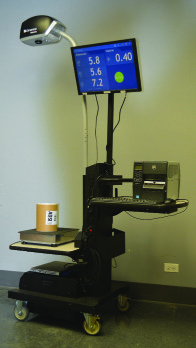Weighing the Value of Dimensional Data
Because you can’t manage what you don’t measure, dimensioning hardware and software solutions are working to provide more precise data than ever—plus the logic to optimize it.
Latest Logistics News
The Ultimate WMS Checklist: Find the Perfect Fit 40th Annual Salary Survey: Salary and satisfaction up Data Capture: Bar coding’s new companions Salary Survey: Pay, satisfaction, youth on the rise Examining the impact of the Taiwan earthquake on global supply chain operations More WarehouseA Supply chain will always be limited by finite resources. Labor is unpredictable and money comes and goes, but space and minutes in a day remain unchanged. For all the efforts to pack productivity into those minutes, much of the supply chain doesn’t have a solid grasp of how much space it uses.
The quantity and dimensions of storage locations can give a sense of capacity, but how full or empty they are—to the cubic inch—can be anybody’s guess. Units and how fast they move tell us something about throughput, but not the total weight to the ounce. And, the precise dimensions of items that leave a building are less than precise, and the parties on either side of the dock are paying or charging accordingly.
The hardware to round up detailed product data and the software to manage it has advanced, but the fundamental components and capabilities are not new. Dimensional (dim) pricing rates, like those UPS and FedEx enacted not quite two years ago, are. Many companies were unprepared, but few were surprised. It’s not hard to foresee a time when the current lack of detailed dimensional data throughout the supply chain will seem quaint.
“It’s like having a pocket full of change and a hole in your pocket,” says Bob Fischer, CEO, president and founder of ADSI. “Consider the pricing break between a parcel under 16 ounces or above. At 15.99 ounces, 1/100th of a pound could cost or save you a few dollars, and that could be the difference between dry or humid corrugate. If you take that hit a thousand times a day it adds up fast. But, not everyone has adopted dim and not everyone is even aware they should.”
Fischer argues dimensional information should be considered from product design to delivery. He also recognizes that embracing these concepts is a complex, specialized journey. Capturing data, leveraging it and ensuring its ongoing integrity is not simple, but for some businesses it means the difference between a viable business model and a failing one.
The scale of the change
The original business case for any cubing and weighing systems was to optimize the use of storage space in the warehouse, according to Randy Neilson, director of sales and marketing for CubiScan. It has now evolved to provide additional value for distribution functions like cartonization and accurate manifesting. It’s one thing for the shipper to know the exact details, but this information is also useful for the carriers as they manage their assets and costs.
“One of their primary desires is to know before they dispatch for a pickup what kind of assets they will need,” Neilson says. “How many trailers? How dense is the load? If they don’t allocate accurately they can incur huge costs they didn’t need to, or they might end up carrying at less than break-even.”
For less-than-truckload operations in particular, Neilson says the strategy has changed from getting as much freight as possible to determining the proper price and increasing yield. Some will make more money with less volume if they price correctly, he says. Ultimately, the consumer bears the cost of any missed opportunities, which can only be seized with a unified strategy among supply chain stakeholders. In the case of dimensioning, Neilson says the placement of data-capturing hardware—like scanners, imagers, scales and dimensioners—will depend on each company’s strategy.
The warehouse or DC might round up information on receipt to coordinate putaway, and in turn optimize order fulfillment decisions, pre-pack, and then shipment manifesting. A vendor might even supply some of the details in advance of receipt, and if the data is detailed enough it might be possible to pre-manifest a shipment—right down to void fill weight—and eliminate the labor to cube and weigh again downstream. Once collected, the dimensions of a new product can be put into the warehouse management system (WMS) or any allocation or order management system.
At packout, the dimensions of pallets, cases and eaches can help an associate pack items, determine the box size and how they should fit. This will optimize packaging, the use of dunnage and shipping expenses. Fischer adds: “If you capture the carton density for two packers who produce at the same speed, but one achieves better density, you can look at the analytics and take that lesson to the rest of the staff.”
“These technologies will only continue to get more and more sophisticated, capturing dimensions, weight and images of envelopes, boxes, tubes and any unit of cartonization,” Fischer says. 
In the meantime, software is often the limiting factor, especially if it lacks the ability to unify disparate data sets and the logic to know what to do with it all.
“It’s not just about dimensions, it’s about inventory management,” Fischer says. “What are the product’s hazardous contents, license requirements or country of origin? The trick is to keep these islands of data in sync.”
Defining the borders
Synchronizing the disparate data streams will require diligence on the part of the end-users as well as solution providers. According to Chris Senneff, cubing product manager for Rice Lake, shipping software and systems in use by third parties often struggle to integrate detailed dimensional data. Something as seemingly simple as a photograph of a shipment at the door can prove the time, date and condition in which it left the building, and validate that it was properly dimensioned and accounted for.
“Some of the detail in the item master might even be presented to consumers online, along with the precise shipping rates the details facilitate,” Senneff says. “When I’ve presented new dimensional solutions to our dealers, some asked why customers would need it. We’ve always been focused on weight, and dim was traditionally only a small part of it, but now it’s taking a big turn in the industry. Shipping managers and accountants are realizing they are losing profits, including some losing thousands of dollars per week in their DCs.”
To get a sense of the losses, shippers can examine freight invoices to identify any upcharges based on density, but it’s often too late to go back to customers to recover the difference. Jason Wiley, business manager for transport and logistics for Mettler-Toledo, says the ideal solutions will depend on volume. For a low-volume shipper, a smart tape measure with bar code scanner can support more accurate pricing.
As volume grows, solutions will trend toward fully automated, Wiley says. A tabletop dimensioning system can automate the data capture, but still requires labor to handle goods. From there, a conveyor-fed system can move items through a dimensioner up to 3 meters per second. Wiley says specialized conveyor-based scales and systems can capture detailed data whether items are singulated or in a mass flow.
 Operations people will always favor that which does not slow things down, but the financial side might want them to take steps to reduce the losses on the outbound side, Wiley says. Occasionally stakeholders have conflicting views, but automated dimensioning reduces the tension between those competing interests to satisfy the finance team while not slowing down the operation.
Operations people will always favor that which does not slow things down, but the financial side might want them to take steps to reduce the losses on the outbound side, Wiley says. Occasionally stakeholders have conflicting views, but automated dimensioning reduces the tension between those competing interests to satisfy the finance team while not slowing down the operation.
“Right now the focus is on the shipping side because of the need for revenue recovery,” Wiley says, “but we see a lot of potential on the receiving end. As fulfillment and distribution centers grow, their warehouse systems will require greater dimensional data to maximize the cube of the warehouse.”

Article Topics
Warehouse News & Resources
The Ultimate WMS Checklist: Find the Perfect Fit 40th Annual Salary Survey: Salary and satisfaction up Data Capture: Bar coding’s new companions Salary Survey: Pay, satisfaction, youth on the rise Examining the impact of the Taiwan earthquake on global supply chain operations Reverse Logistics: Best Practices for Efficient Distribution Center Returns Exploring Customized Forklift Solutions More WarehouseLatest in Logistics
Understanding the FTC’s ban on noncompetes UPS rolls out fuel surcharge increases U.S. rail carload and intermodal volumes, for week of April 20, are mixed, reports AAR Baltimore suing ship that crashed into bridge, closing port, costing jobs Intermodal growth volume remains intact in March, reports IANA Descartes announces acquisition of Dublin, Ireland-based Aerospace Software Developments Amid ongoing unexpected events, supply chains continue to readjust and adapt More LogisticsAbout the Author
Subscribe to Logistics Management Magazine

Find out what the world's most innovative companies are doing to improve productivity in their plants and distribution centers.
Start your FREE subscription today.
April 2023 Logistics Management

Latest Resources















